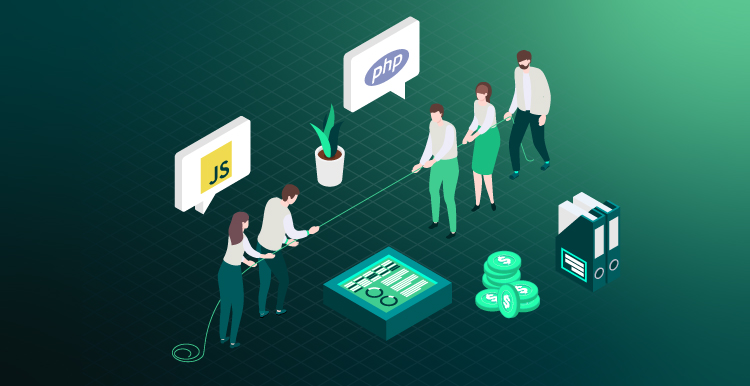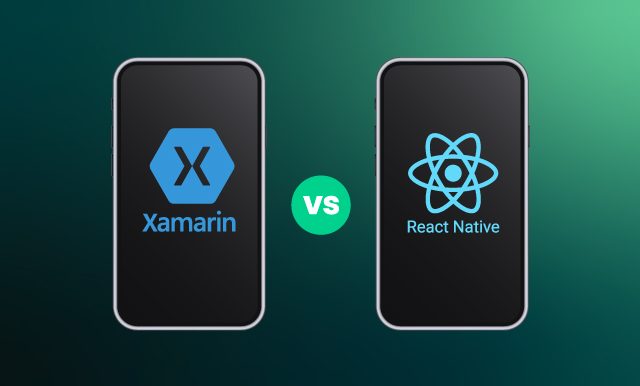The success of any endeavor is largely conditioned by the correct choice of instruments and technologies for its implementation. This basic truth works in the high-tech realm as well, where you must opt for the proper toolset to see a certain project through. A prominent place in this set belongs to the programming language, and very often, the choosing issue boils down to the PHP vs Javascript dilemma.
There is a widespread opinion in the IT community that PHP is meant for back-end development, while Java is the cure for front-end design. However, contrasting the server-side designation of PHP and the client-side mission of JS is a gross oversimplification. Besides, the advent of a new wave of Java-based frameworks (Angular.js, React.js, and Node.js, to mention a few) showed that server-side scripting could be done not only by employing PHP; JavaScript can now be used to handle it as well.
In light of this, comparing PHP vs. JS doesn’t look like matching up apples and oranges anymore but becomes a necessary preliminary stage to turn the choice of a programming language for a particular project into a knowledgeable decision.
Brief Overview of Each Language
PHP is now interpreted as a recursive acronym standing for Hypertext Preprocessor. But at the time of its invention (and that was back in 1994), it was short for Personal Home Page tool. During over a quarter of the century, it has expanded its sway, becoming the principal technology for the back-end development of digital products. In fact, more than three-fourths of all web pages of different nature (regular sites as well as picture galleries, login pages, database-driven sites) are built with it, including such heavy-duty websites as Wikipedia or Facebook.
The open-source character of this language enables PHP-powered solutions to be run on all existing operating systems (Windows, macOS, Linux, UNIX). PHP instances aren’t limited to websites only but also include servers (MySQL, PostgreSQL, MariaDB) and Content Management Systems (WordPress, Drupal, Joomla).
JavaScript is one year younger than PHP, but it has become the number one client-side programming language leveraged by almost 68% of developers worldwide, according to the latest Stack Overflow Survey. It is typically utilized for building dynamic and interactive web pages and user-friendly non-web products like mobile apps or computer games.
Alongside its original front-end purpose, sophisticated in such frameworks as Angular.js, Backbone.js, and Ember.js, JavaScript found application in server-side technologies (for instance, Express.js or MongoDB). These transformations allowed Java to trespass on the core PHP bounds and become a worthy competitor in the niche.
JS vs. PHP: Zooming in on Similarities
Being high-profile programming languages widely used in various kinds of IT projects, JavaScript and PHP expose numerous common features. Both of them are interpreted and object-oriented. They are sensitive to variables and offer memory management capabilities. Besides, each of them supports frameworks, requires HTTP to execute, and is platform-independent.
Given these similarities, the languages can become a powerful software development booster when used in combination. If programmers apply PHP for back-end creation and Java for the front-end design, they get access to a solid number of libraries, a huge codebase of frameworks, and powerful community support. The combo brings maximum value in developing iGaming sites that can host a range of highly responsive online games.
Despite multiple shared features, JavaScript and PHP are still two distinct languages whose characteristics can be juxtaposed against each other.
PHP vs. Java: Differences Pinpointed
While comparing these languages, it makes sense to go through the essential aspects of their usage and functioning.
1. Universality
Both languages are cross-platform, which makes them excellent tools for building applications running on different operating systems. Mostly, such solutions are web apps, though Java and PHP are good for mobile apps too.
However, JavaScript has a weighty edge over PHP since it is a full-stack development medium. It means that Java can be employed for creating both the front-end and back-end of the digital product, while PHP’s area of responsibility is only the latter. In fact, it is a part of the so-called LAMP stack, where other technologies are Linux, Apache, and MySQL. Besides, a software engineer must also be fluent in HTML and CSS to accomplish the end-to-end development of a product with PHP. Naturally, switching between multiple syntax systems is inconvenient and requires a wider scope of skills.
The verdict: JavaScript 1 – PHP 0.
2. Combinability
The roster of technologies PHP can play well with is quite limited. These are HTML and the already mentioned components of the LAMP stack. Plus, PHP can be extended by two specialized package managers (Composer and PEAR). Such a meager list would make the usage of PHP rather deficient, but for the existence of CMSs (Drupal or WordPress) that dramatically facilitate web development efforts.
By contrast, JavaScript can be combined not only with HTML but with XML and Ajax as well. Besides, there are a plethora of Java-based frameworks which can be employed both for front-end and back-end development. One of the latter (Node.js) comes with a package manager called NPM, granting access to the most voluminous software registry in the world.
The verdict: JavaScript 2 – PHP 0.
3. Performance
This quality is largely conditioned by the concurrency each language allows. Simply put, it means that all threads start and end at the same time, so the task isn’t accomplished unless the processing of sub-threads and threads is over.
Java, with its event-driven and non-blocking input/output execution model, can run the entire code concurrently and doesn’t need to wait for any functions to be executed. Such single-threaded nature of it makes JavaScript a perfect choice for developing low-latency software (for instance, streaming solutions).

PHP is everything Java is not. It is multi-threaded and synchronous, which spells I/O blocking operation pattern. As a result, any next code line can’t be executed until the previous one is, which hinders the speed considerably.
The verdict: JavaScript 3 – PHP 0.
4. Simplicity
Despite the powerful nature of PHP and the huge library it relies on, its learning curve is quite mild in comparison with the one JavaScript requires. The return values and inconsistent functions found in PHP are simple to grasp, whereas the usage of event queue, advanced features, and violation of rules traditional for other programming languages turns mastering Java into a rather demanding ordeal.
It is true that thanks to its universality, once learned, JavaScript can pay back in value this knowledge brings. Yet it doesn’t make the effort of learning JS any easier.
The verdict: JavaScript 3 – PHP 1.
5. Community
Neither language outstrips the other in the size of the community and businesses that employ it for creating their products. On the one hand, JavaScript is used by many major-league brands, such as Airbnb, Uber, Trello, Netflix, Instagram, eBay, NASA, LinkedIn, etc. On the other hand, the roster of PHP blue-chip users is no less impressive with Facebook, Tumblr, Slack, Lyft, MailChimp, Etsy, Spotify, Upwork, and Wikipedia. So both technologies score a point in this aspect.
The verdict: JavaScript 4 – PHP 2.
6. Availability
This feature is also known as script ownership because it defines the code owner who can also modify it. Since PHP is an open-source language, its source code is free for developers to use and transform. One may say that the whole Internet community owns it and can introduce changes to it. Such nature also means that you can count on assistance and advice from commonplace users of PHP. While most JS-fueled frameworks are open source, too, the language itself is not. JavaScript as an open standard program is maintained by Ecma International and W3C.
The verdict: JavaScript 4 – PHP 3.
7. Syntax
This is the essence of any communication system, and it holds the same importance for programming languages as well. Its organization ultimately determines how simple or complex a language is and exposes the unique approach utilized to reach the project goal. Let’s have a quick look at the most prominent syntactic features each language manifests.
- Both languages have a complete gamut of bracket types, such as round, square, and curly.
- There are different approaches to performing addition and concatenation. In JavaScript, both are done with “+,” whereas in PHP, only addition is done with this symbol, while for concatenation, “.” is used.
- Languages have different ways of referencing objects: an arrow (->) in PHP but a full stop (.) in JavaScript.
- The sets of arrays each language employs vary as well because PHP allows both numeric and associative (aka key-value pairs) arrays, while Java lacks the latter. In it, in case you want to employ one, you must leverage JSON strings instead. However, in both languages, arrays begin with “0”.
- There is a notable difference between the languages in the treatment of objects and arrays. In PHP, objects and arrays are two separate entities that require distinct syntactic structures to be used in. In Java, they are items of identical order, so they can be switched at will. Moreover, an object can be referenced as an array and vice versa.
- Case sensitivity in the languages is unlike. JavaScript extends it to classes, functions, and variables, whereas in PHP, only the latter type of sensitivity is in evidence.
- Both languages allow for variables of any type, and the type can be changed. But if you want to find out what type a variable is, you have to call a different operator – “gettype” in PHP and “typeof” in JavaScript.
- Variables are also marked differently. In PHP, they are preceded by the dollar sign ($), while in JavaScript, no special symbol is employed before a variable.
- Languages take opposite approaches to recognizing the nature of variables. In PHP, all variables are considered local unless declared otherwise (that is, global). On the contrary, in JavaScript, a variable is understood as global by default if it is not declared local by means of “var.” In case it is, the variable can be utilized with any purpose covered by this function or subfunction.
- Boolean variables get different treatments, too. The word “true” can be spelled either in lowercase or uppercase in PHP but in JS, only the lowercase word is recognized and accepted.
As one can easily assume, the enumerated differences don’t make either PHP or JavaScript inferior to the other, so they both deserve a point in this standoff. As far as it comes to syntax, personal tastes are the chief reason that makes a developer prefer one language over the other. You should decide for yourself which syntactic style agrees with you better.
The verdict: JavaScript 5 – PHP 4.
8. Runtime Environments
Until recently, PHP led the way in this aspect due to the foolproof installation procedure and the Zend Engine it employed as both a compiler and a run-time engine. With the advent of Node.js, JavaScript acquired a runtime environment executed on the V8 JavaScript runtime engine. This technology has opened the entire range of server-side operations to JavaScript, such as data analysis, controlled access to content, or customized UX. As a result, both languages can now be seamlessly integrated with HTML code, although requiring different interpreters to run it.
The verdict: JavaScript 6 – PHP 5.
Evidently, neither PHP nor Java has a decisive superiority over the other, exposing both merits and demerits, so the choice of the programming language should be made with an eye to the project you are going to implement.
Recommended PHP and JavaScript Use Cases
As a seasoned IT vendor with a plethora of successfully completed software products in the portfolio, Forbytes has figured out where each language is more efficient.

Thanks to its dedicated server hosting, JavaScript is just what the doctor ordered for the front-end and back-end development of large projects, including IoT solutions, 3D games, AR/VR software, etc. Just make sure that this project involves the following:
- Express.js, Node.js, MongoDB, or similar server technologies;
- React.js, Ember.js, Angular.js, Backbone.js, or other front-end frameworks;
- MEAN-type solution stacks;
- Dynamic single-page applications.
Being a general-purpose programming language, PHP is typically employed for creating the back-end of dynamic web pages, such as blogs, e-commerce websites, or learning management systems. If you opt for PHP, you should apply it in the use cases covering:
- Drupal, WordPress, Joomla, or other CMS;
- LAMP-type solution stacks;
- MariaDB, PostgreSQL, Oracle, or other servers of this type.
In case you are still in doubt as to the choice of the language for your project, pull a shrewd move by combining PHP with Java for the back-end and front-end development correspondingly and enjoy the best of both worlds.
Drawing a Bottomline
Traditionally, PHP and JavaScript are viewed as programming languages employed for building a specific aspect of a software product – the former for the back end and the latter for the front end. However, the appearance of Java-powered frameworks became a game-changer that enabled JS to be used for server-side endeavors. That is why the question of choice of the proper language for a digital project is now relevant.
There is no universal recipe for selection since each language has its assets and downsides, so you should rather look at the project you are going to utilize it for. The developer staff of Forbytes has sufficient skills and experience to not only advise you on the choice but efficiently use both languages to build a first-rate software product of any type and complexity.

Our Engineers
Can Help
Are you ready to discover all benefits of running a business in the digital era?

Our Engineers
Can Help
Are you ready to discover all benefits of running a business in the digital era?







